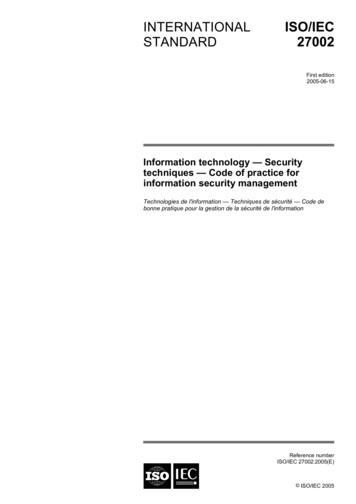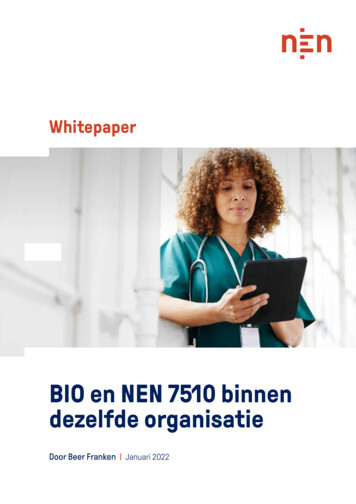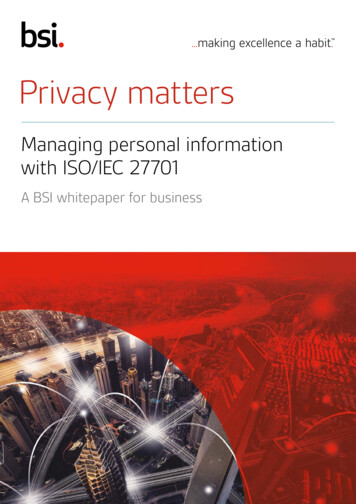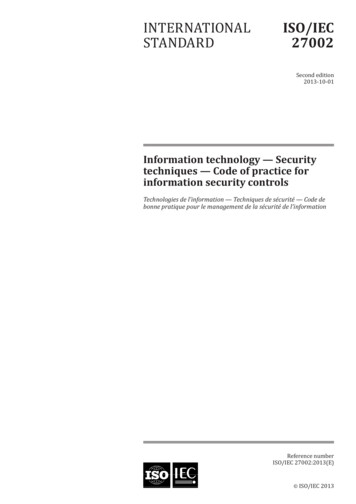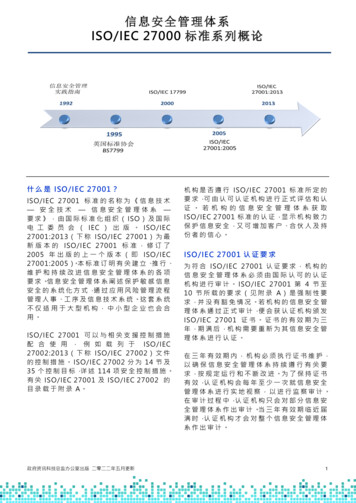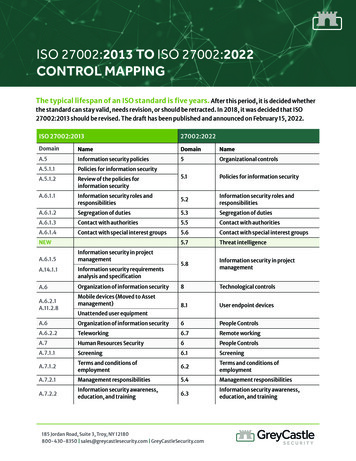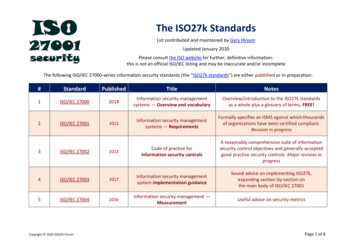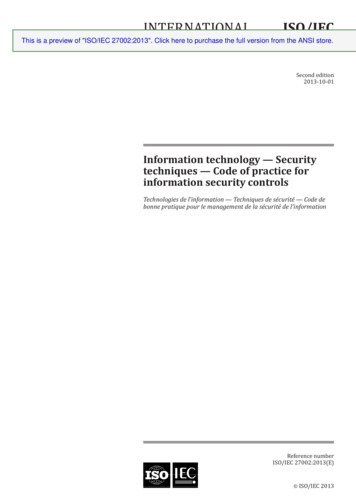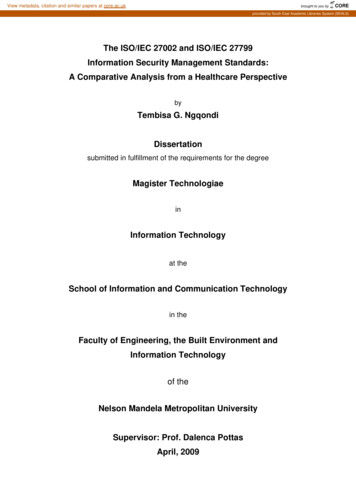
Transcription
View metadata, citation and similar papers at core.ac.ukbrought to you byCOREprovided by South East Academic Libraries System (SEALS)The ISO/IEC 27002 and ISO/IEC 27799Information Security Management Standards:A Comparative Analysis from a Healthcare PerspectivebyTembisa G. NgqondiDissertationsubmitted in fulfillment of the requirements for the degreeMagister TechnologiaeinInformation Technologyat theSchool of Information and Communication Technologyin theFaculty of Engineering, the Built Environment andInformation Technologyof theNelson Mandela Metropolitan UniversitySupervisor: Prof. Dalenca PottasApril, 2009
DedicationMy sincerest gratitude and appreciation are extended to: God, Almighty for all the blessings he gave me; My Supervisor, Professor Dalenca Pottas for her trustworthiness, support;advice and patience. Prof. you are exceptional, thank you for your tirelesssupport; My daughter Lithemba and my sister Zanele for their understanding andcontinuous support; My employer WSU and colleagues in my department for their support; My Family and Friends for their support. Finally, to Debbie for all the time she spent proofreading this dissertation.
DEPARTMENT OF ACADEMIC ADMINISTRATIONEXAMINATION SECTIONSUMMERSTRAND NORTH CAMPUSPO Box 77000Nelson Mandela Metropolitan UniversityPort Elizabeth6013Enquiries: Postgraduate Examination OfficerDECLARATION BY CANDIDATENAME:Tembisa NgqondiSTUDENT NUMBER:20008669QUALIFICATION:Magister Technologiae: Information TechnologyTITLE OF PROJECT:The ISO/IEC 27002 and ISO/IEC 27799Information Security Management Standards:A Comparative Analysis from a Healthcare PerspectiveDECLARATION:In accordance with Rule G4.6.3, I hereby declare that the above-mentioned treatise/dissertation/ thesis is my own work and that it has not previously been submitted forassessment to another University or for another qualification.SIGNATURE:DATE: 2009, January, 23
Table of ContentsList of Figures .ivList of Tables. vAbstract.viChapter 1: Introduction. 11.1.Background . 11.2.Problem Statement . 61.3.Research Objectives . 71.4.Research Methodology . 71.5.Structure of the Dissertation . 81.6.Conclusion . 10Chapter 2: The Healthcare Sector . 112.1.Background . 112.2.Technological Advancements in the Healthcare Sector . 142.2.1.Challenges of Technological Advancements in the HealthcareSector . 162.2.2.Benefits of Technological Advancements in the HealthcareSector . 192.2.2.1.Changes in the Practitioner/Patient Relationship . 202.2.2.2.Secondary Uses of Health Data . 202.3.The Unique Security Needs of the Health Sector . 212.4.Conclusion . 24Chapter 3: Information Security Management Standards . 263.1.Introduction . 263.1.1.Information Security . 273.1.1.1.Confidentiality . 273.1.1.2.Integrity . 283.1.1.3.Availability . 28The ISO/IEC 27002 and ISO/IEC 27799 Information Security Management Standards:A Comparative Analysis from a Healthcare Perspectivei
3.1.2.3.1.3.3.2.Risk Management . 283.1.2.1.Risk Identification . 293.1.2.2.Risk Assessment . 293.1.2.3.Risk Treatment . 30Information Security Management . 30ISO 27002:2005 - Information Technology Security Techniques: Code ofPractice for Information Security Management . .313.3.3.2.1.Introduction . 313.2.2.Terminology Used in the ISO 27002 . 323.2.3.The Difference between ISO 17799:2000 and ISO 27002:2005 . 333.2.4.The Content of the ISO/IEC 27002 . 343.2.5.The Eleven Security Clauses of the ISO/IEC 27002 . 35ISO 27001:2005 - Information Technology Security Techniques: InformationSecurity Management Systems Requirements . 373.4ISO 27799: 2008 - Health Informatics: Information Security Management inHealth Using ISO/IEC 27002 . 403.53.4.1.Introduction . . . . 403.4.2.The content of the ISO 27799 . . . . . 41Conclusion . . . 41Chapter 4: A Comparative Analysis of the ISO/IEC 27002 and ISO/IEC 27799Information Security Management Standards . 434.1.Background . 444.2.High Level Comparison of ISO 27002 and ISO 27799 . 444.3.ISO 27002 (Sections 0 - 4) versus ISO 27799 (Introduction andSections 1 - 6) . .474.3.1.4.4.Part I: Findings of the Comparison. 51Part II: ISO 27002 (Sections 5 - 15) versus ISO 27799 (Section 7) . .524.4.1.Structural Comparison . 534.4.2.Part II: Findings of the Structural Comparison . 564.4.3.Part II: Detailed Comparison . 574.4.4.Part II: Findings of the Detailed Comparison . 58The ISO/IEC 27002 and ISO/IEC 27799 Information Security Management Standards:A Comparative Analysis from a Healthcare Perspectiveii
4.5.Part III: Comparison of Attachments Included in the Standards . 614.5.1.Part III: Findings of the Comparison of Appendices . . 644.6.Critique: Contribution of ISO 27799 to Security Needs of Health Sector . .644.7.Conclusion . .66Chapter 5: Conclusion . 685.1.Background . 685.2.Re-examining the Sub-Objectives of the Research . 695.3.Chapter Overview . .715.3.1.Chapter 1 - Introduction . 715.3.2.Chapter 2 - Healthcare Sector Structure . 715.3.3.Chapter 3 - Information Security Management Standards . 725.3.4.Chapter 4 - Comparison: ISO 27002 versus ISO 27799 . 735.3.5.Chapter 5 - Conclusion . 745.4.Benefits and Limitations of the Research . .745.5.Future Research . 755.6.Conclusion . . . . .76References . . .78Appendix A1 . . . . . .88Appendix A2 . . . . .124The ISO/IEC 27002 and ISO/IEC 27799 Information Security Management Standards:A Comparative Analysis from a Healthcare Perspectiveiii
List of FiguresFigure 1.1: Layout of Dissertation . 9Figure 2.2: Patient Support Systems in the Healthcare Sector . 22Figure 3.1: ISO 17799:2000 Edition and ISO 27002:2005 Updated EditionControl Objectives and Controls . 34Figure 3.2: Plan-Do-Check-Act Model Applied to ISMS Processes . 39Figure 4.1: High Level Comparison of the ISO 27002 and ISO 27799 Standards. 45Note that Figure 4.1 is also included as Appendix A2 (p. 124) in a fold-out format tofacilitate viewing of the diagram while reading Chapter 4.The ISO/IEC 27002 and ISO/IEC 27799 Information Security Management Standards:A Comparative Analysis from a Healthcare Perspectiveiv
List of TablesTable 3.1: ISO 17799:2000 Edition vs ISO 27002:2005 Updated Edition Security .Clauses . 33Table 4.1: ISO 27002 (Sections 0 – 4) versus ISO 27799 (Introduction andSections 1 – 6) . . 47-51Table 4.2: ISO 27002 (Sections 5 – 15) versus ISO 27799 (Section 7) . 54-55Table 4.3: ISO 27002 versus ISO 27799 (Total Number of Clauses,MSCs and Controls) . 56Table 4.4: ISO 27002 versus ISO 27799 (Appendices) . 62-64Table 4.5: Summary of New Clauses, MSCs and Controls in ISO 27799 . .65The ISO/IEC 27002 and ISO/IEC 27799 Information Security Management Standards:A Comparative Analysis from a Healthcare Perspectivev
AbstractTechnological shift has become significant and an area of concern in the healthsector with regard to securing health information assets. Health information systemshosting personal health information expose these information assets to ever-evolvingthreats. This information includes aspects of an extremely sensitive nature, forexample, a particular patient may have a history of drug abuse, which would bereflected in the patient’s medical record. The private nature of patient informationplaces a higher demand on the need to ensure privacy. Ensuring that the securityand privacy of health information remain intact is therefore vital in the healthcareenvironment.In order to protect information appropriately and effectively, good information securitymanagement practices should be followed. To this end, the InternationalOrganization for Standardization (ISO) published a code of practice for informationsecurity management, namely the ISO 27002 (2005). This standard is widely used inindustry but is a generic standard aimed at all industries. Therefore it does notconsider the unique security needs of a particular environment. Because of theunique nature of personal health information and its security and privacyrequirements, the need to introduce a healthcare sector-specific standard forinformation security management was identified. The ISO 27799 was thereforepublished as an industry-specific variant of the ISO 27002 which is geared matics.Itservesasanimplementation guide for the ISO 27002 when implemented in the health sector.The publication of the ISO 27799 is considered as a positive development in thequest to improve health information security. However, the question arises whetherthe ISO 27799 addresses the security needs of the healthcare domain sufficiently.The extensive use of the ISO 27002 implies that many proponents of this standard(in healthcare), now have to ensure that they meet the (assumed) increasedrequirements of the ISO 27799. The purpose of this research is therefore to conducta comprehensive comparison of the ISO 27002 and ISO 27799 standards todetermine whether the ISO 27799 serves the specific needs of the health sector froman information security management point of view.The ISO/IEC 27002 and ISO/IEC 27799 Information Security Management Standards:A Comparative Analysis from a Healthcare Perspectivevi
Chapter 1Chapter 11 IntroductionThe aim of Chapter 1 is to provide an overview of the dissertation. This includespresenting the problem statement, research questions, objectives and theresearch methodology of the research project. The chapter layout of thedissertation is presented in graphical format together with a brief overview of eachchapter.1.1 BackgroundEvents where individuals have had their privacy rights breached are not new in thehealthcare domain (Maseti, 2008). Various incidents can be cited, viz.: In a report released by the Government Accounting Office in the United States(as cited in Maseti, 2008), over 40% of federal health insurance contractors andmedical aid agencies reported experiencing a privacy breach involving personalhealth information over the past two years. In a recent special investigation by The Times newspaper, it was reported thatthe medical record of Dr. Manto Tshabalala-Msimang, who was Minister of Healthat the time, was stolen from the private clinic where she was admitted. It wasthen passed on illegally to a news reporter, who used it to write an article thatexposed the minister’s behavior when she was admitted to the clinic (Maker &Power, 2007). More than a decade ago a report by the U.S. Congress (U.S. Congress, 1993)suggested that information brokering was a widespread problem and providedthe example of a Medical Information Bureau, where information was gatheredand banked solely for the purpose of assisting the insurance industry in makingcoverage exclusions in their policies.The ISO/IEC 27002 and ISO/IEC 27799 Information Security Management Standards:A Comparative Analysis from a Healthcare Perspective1
Chapter 1The afore-mentioned reports and events clearly highlight the challenges of handlingsensitive patient information in the health sector. Dube, Mtenzi & Shoniregun (2008)indicate that the domain of healthcare has become a challenging testing ground forinformation security due to the complex nature of healthcare information andindividual privacy. Electronic health records stored at individual organizations arevulnerable to internal and external agents that seek to violate the security andconfidentiality policies of the specific organization (National Academies Press, 1997).The vulnerability of health records raises concerns regarding the privacy and securityof health information.The National Academies Press (1997) states that privacy and security of healthinformation concerns are classified into two categories namely: Concerns about the inappropriate release of information from individualorganizations, whereby this can originate either from authorized users whointentionally or unintentionally access or disseminate information in violation oforganizational policy, or from outsiders who break into an organization’s storagesystem; and Concerns about the systemic flows of information throughout the healthcare andrelated industries whereby this concern refers to the open disclosure of patientidentifiable health information to parties that may act against the interests of thespecific patient or may otherwise be perceived as invading a patient’s privacy.These concerns give emphasis to the reference by Dube et al. (2008) to the complexnature of healthcare information and individual privacy. In a report distributed by thInformationManagement Association is cited as defining health information or healthcareinformation as any data or information, whether oral or recorded in any form ormedium, that identifies or can readily be associated with the identity of a patient orother recorded subject; and 1) relates to a patient’s health care; or 2) is obtained inthe course of a patient receiving treatment from a health care provider, from thepatient, from a member of the patient’s family or an individual with whom the patientThe ISO/IEC 27002 and ISO/IEC 27799 Information Security Management Standards:A Comparative Analysis from a Healthcare Perspective2
Chapter 1has a close personal relationship, or from the patient’s legal representative. Thereport further recognizes that parties who are not directly involved in patient carealso gather and maintain healthcare information, for example educational institutions,the civil and criminal justice systems, pharmacies, life and health insurers,rehabilitation and social welfare programs, credit agencies and banking centres,public health agencies, and medical and social researchers.The ISO 27799 standard defines personal health information (which excludesanonymized information) as information about an identifiable person which relates tothe physical or mental health of the individual, or to provision of health services tothe individual, and which may include (ISO 27799, 2008):a) information about the registration of the individual for the provision of healthservices;b) information about payments or eligibility for healthcare with respect to theindividual;c) a number, or particular symbol assigned to an individual to uniquely identifythe individual for health purposes;d) any information about the individual collected in the course of the provision ofhealth services to the individual;e) information derived from the testing or examination of a body part or bodilysubstance; andf) identification of a person (e.g. a health professional) as provider of healthcareto the individual.While it is not the intention at this stage to argue the appropriateness of ordifferences in the afore-mentioned definitions, the fact remains that in order toprotect health information, it must be understood what precisely is constituted by theterm. From the two definitions listed the complex nature of health information can beconfirmed. It must be understood that the full range of health information must beprotected in order to ensure that privacy and security concerns are addressedappropriately.The ISO/IEC 27002 and ISO/IEC 27799 Information Security Management Standards:A Comparative Analysis from a Healthcare Perspective3
Chapter 1Nemasisi (2007) cautions that the improper use or disclosure of health informationcould have disastrous consequences and that there are various laws that regulatethe use and disclosure of information in the health sector. The legal liability to ensurethat health information is protected, cannot be ignored. Locally, notable laws includethe South African National Health Act (SANHA), the Electronic Communication andTransactions Act (ECTA), and the Traditional Health Bill (Tuyikeze & Pottas, 2005).Further afield the Health Insurance Portability and Accountability Act (HIPAA) fromthe United States is well-known.In order to comply with legal requirements and show that due care was appliedregarding the protection of health information, healthcare organizations implementcomprehensive information security programmes. Von Solms & Von Solms (2006)argue that due care can be applied by implementing some form of best practices inthe protection of critically important company information assets. This can beachieved by using information security management (ISM) standards or guidelines.Widely known examples of ISM standards, include: ISO/IEC 27002: 2005 Information Technology Security Techniques Code ofPractice for Information Security Management, which sets out guidance andgeneral principles for initiating, implementing, maintaining, and improvinginformation security management in an organization. It contains best practicesregarding control objectives and controls in information security management(ISO 27002, 2005). ISO/IEC 27001: 2005 Information Technology Security Techniques InformationSecurity Management Systems Requirements, which specifies the requirementsfor establishing, implementing, operating, monitoring, reviewing, maintaining andimproving a documented Information Security Management System within thecontext of the organization’s overall business risks. It specifies requirements forthe implementation of security controls customized to the needs of individualorganizations or parts thereof (ISO 27001, 2005).The ISO/IEC 27002 and ISO/IEC 27799 Information Security Management Standards:A Comparative Analysis from a Healthcare Perspective4
Chapter 1It should be noted that for the sake of brevity, this dissertation generally refers to atherthanISO/IEC 27001 and ISO/IEC 27002. This applies to other standards such as theISO 27799 as well.Box (2008) notes that the Code of Practice for ISM is well-accepted and widelyadopted within industry, is used globally and is well-advocated within the securitypractitioner community. Siponen (2002) comments that although it is widely used, itis broadly-written, thereby failing to consider that organizations and their securityneeds differ. It therefore does not address unique security needs but instead,prescribes universal procedures advocated by security practitioners (Siponen, 2003).This is supported in the ISO 27002 (2005), which states that:“Controls can be selected from this standard or from control sets, or newcontrols can be designed to meet the specific needs of the organization. It isnecessary to recognize that some controls may not be applicable to everyinformation system or environment and might not be practicable for allorganizations.”The ISO 27799 (2008) standard indicates that:“ISO 27002 is a broad and complex standard and its advice is not tailoredspecifically to healthcare.”For this reason, the ISO 27799 standard was released in 2008 to address the specialinformation security management needs of the health sector and its unique operatingenvironments (ISO 27799, 2008). The ISO 27799: 2008 (Health Informatics Information Security Management in Health using ISO/IEC 27002) providesguidance to healthcare organizations and other custodians of personal healthinformation on how best to protect the confidentiality, integrity and availability of suchinformation by implementing ISO/IEC 27002 (ISO 27799, 2008).The ISO/IEC 27002 and ISO/IEC 27799 Information Security Management Standards:A Comparative Analysis from a Healthcare Perspective5
Chapter 1Although the title of the ISO 27799 refers to the ISO 27002 only, the standard statesin its Introduction that:“It is not intended to supplant ISO/IEC 27002 or ISO/IEC 27001. Rather, it is acomplement to these more generic standards.”The standard therefore attempts to address the implementation of an informationsecurity management system (ISMS) as well, rather than addressing the ISMS in aseparate standard as was done in the ISO 27001.From the discussion it is clear that a new standard, viz. the ISO 27799 has beenpublished to address the unique needs of the health sector in terms of informationsecurity management. This leads to an introduction of the problem statement that isaddressed in this research.1.2 Problem StatementThe health sector is a vast and complex environment that handles critical healthinformation. Health-sector-specific security requirements are encapsulated in theISO 27799 standard. The main problem addressed in this research is whether theISO 27799 standard serves the needs of the health sector from an informationsecurity management point of view. In order to investigate this properly the followingresearch questions must be answered: How is the health sector constituted and what are the unique security needs ofthe health sector? How can these needs be addressed through proper information securitymanagement practices? How does the overall structure of the ISO 27002 and ISO 27799 standards differ? How do the eleven security control clauses and 39 main security controlcategories described in ISO 27002, differ in ISO 27799? Will the application of the ISO 27799 ensure that privacy and security of healthinformation concerns are addressed adequately and continuously throughestablishing a robust information security management system?The ISO/IEC 27002 and ISO/IEC 27799 Information Security Management Standards:A Comparative Analysis from a Healthcare Perspective6
Chapter 1Addressing the afore-mentioned research questions support the achievement of themain and secondary research objectives that are subsequently discussed.1.3 Research ObjectivesThe main objective of this research is to determine whether the ISO 27799 standardserves the needs of the health sector from an information security management pointof view. This is achieved by addressing the following list of secondary objectives thatsupport the primary objective: Investigate the health sector and the special needs of health information security. Examine information security management practices in general as well as in thehealth sector. Perform a high level comparison of the ISO 27002 and ISO 27799 standards. Execute and document the results of a detailed comparative analysis of thesecurity control clauses in both standards. Determine the approach of the ISO 27799 in regard to the establishment of aninformation security management system. Based on the afore-mentioned actions, critique the contribution of the ISO 27799to serving the security needs of the health sector.In order to achieve these objectives, the following research methods were applied.1.4 Research MethodologyTwo research methods were used to achieve the objectives of this study, viz.literature review and comparative analysis. The literature study was conducted toreview secondary literature about the topics relevant to this research. This includes: The health sector and its special security needs; Information security management standards and best practices; Establishing an information security management system; and Information security management as pertaining to the health sector.The ISO/IEC 27002 and ISO/IEC 27799 Information Security Management Standards:A Comparative Analysis from a Healthcare Perspective7
Chapter 1The sources used to do the literature review were selected based on availability andtrustworthiness.After a clear understanding of the health sector, its security needs and informationsecurity management practices were established, a comprehensive comparativeanalysis of the ISO 27002 and ISO 27799 standards was executed and documented.According to Hofstee (2006), when doing a comparative analysis, the researcherinvestigates in a focused and systematic manner two, sometimes three items indepth and compares them to each other to find differences or similarities. Thisapproach suits the objective of this research. The case for comparing the twostandards as a means of serving the objective of the research is based on: The fact that the ISO 27002 standard is a recognized and widely usedinternational standard for information security management. The fact that the ISO 27799 is based on the ISO 27002.The comparison of the standards identifies aspects that were added (throughmodification or addition) to provide guidance to healthcare organizations. This allowsthe researcher to critique the contribution of the ISO 27799 in regards to serving theinformation security management needs of the health sector.1.5 Structure of the DissertationThe layout of the dissertation is divided into three sections and five chapters and isdepicted in Figure 1.1.Section 1 is comprised of the first three chapters of the dissertation and covers thebackground of the research area. Chapter 1 provides a brief introduction of thedissertation and expounds the problem statement, objectives, and methodology ofthe research. Chapter 2 discusses the nature of the health sector, investigatestechnological advancements in this sector and the challenges and benefits of thechanges brought about by these advancements. The importance of protectingpersonal health information is confirmed. Chapter 3 introduces risk management andinformation security management and provides an overview of the relevantThe ISO/IEC 27002 and ISO/IEC 27799 Information Security Management Standards:A Comparative Analysis from a Healthcare Perspective8
Chapter 1standards. It also explicates the advancement of the standards through variouseditions.Section 1Chapter 1IntroductionChapter 2Healthcare SectorChapter 3Information Security ManagementStandardsIntroduction and Problem AnalysisSection 2Chapter 4Comparative Analysis:ISO 27002 vs. ISO 27799Results of the AnalysisSection3Chapter 5ConclusionCritical Review of DissertationFigure 1.1: Layout of DissertationThe ISO/IEC 27002 and ISO/IEC 27799 Information Securit
Figure 4.1: High Level Comparison of the ISO 27002 and ISO 27799 Standards . 45 Note that Figure 4.1 is also included as Appendix A2 (p. 124) in a fold-out format to facilitate viewing of the diagram while reading Chapter 4. The ISO/IEC 27002 and ISO/IEC 27799 Information Security Management Standards:
